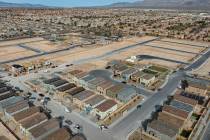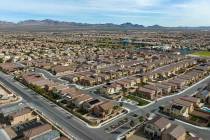With a little help, family feels at home

Shana Andrea doesn’t care about being first.
She’s just grateful to finally have a home.
The 37-year-old single mother and her four children are the first Southern Nevada family to finalize purchase of a home with help from the Neighborhood Stabilization Program, a year-old federal program designed to help communities hardest hit by foreclosures redevelop and repopulate foreclosed homes.
Nevada has the highest foreclosure rate in the nation, and thousands of valley homes have been foreclosed on.
Through the program, Andrea, who makes less than $30,000 a year as a clerk in a casino accounting department, was able to buy a 1,000-square-foot, three-bedroom foreclosed home near Boulder Highway and Sunset Road, for $49,500.
Her monthly payment? $426.
"I knew I could never afford to rent a place," said Andrea, who for several years has been living along with her children at the homes of friends. "This is wonderful."
Some $3.9 billion nationally was allocated in the program’s first round of funding, approved by President George W. Bush. Nearly $72 million of that wound up in Nevada.
Another $1.9 billion in stabilization funds nationally is in the pipeline under the economic stimulus package signed this year by President Barack Obama.
Much of the money is being funneled to nonprofit organizations to buy vacant, distressed homes that will be offered as affordable housing.
Some funds also will go toward constructing new affordable housing and demolishing blighted homes and buildings.
The city of Henderson received $4.1 million and is administering a portion of the funds to help people such as Andrea become first-time home buyers.
To qualify for the program, applicants cannot earn more than 120 percent of the area’s median income, $76,700 for a family of four. About 25 percent of program recipients must be in a much lower income bracket, making less than $31,900 for a family of four.
Applicants also must agree to buy a home in neighborhoods identified as having the highest percentage of home foreclosures.
Qualified buyers receive a federal loan of up to $50,000 that must be repaid if the home is sold within five years.
After that, the amount that must be repaid gradually declines to zero after 15 years of home ownership.
Henderson’s Neighborhood Services Department guided Andrea through the process.
The city provided her with $3,000 toward her down payment and about $25,000 for repairs and improvements to the home, which had fallen into disrepair.
Andrea was required to kick in at least $1,500 toward the down payment on her own; she managed to contribute $2,000. She also had to attend an eight-hour class about home ownership, find a real estate agent, a property and a lender. And her credit had to be good enough to qualify for a 30-year fixed mortgage.
With its comparatively small pot of money, Henderson is ahead of other local governments in distributing stabilization program funds. For information about the city’s homebuyers assistance program, call 702-267-2010.
Las Vegas, Clark County and North Las Vegas, whose collective allocation comes to more than $60 million, plan to pass along a portion of those funds to nonprofits to administer their home buyers assistance programs for them.
The Neighborhood Stabilization Program doesn’t include assistance for people facing foreclosure, and it has been criticized for it.
Some officials have complained about feeling handcuffed by rules that won’t allow them to chip in money for houses already in foreclosure, calling the program only a partial solution.
Las Vegas Mayor Oscar Goodman has called the approach "topsy-turvy," saying it doesn’t go far enough to help those heading into foreclosure.
Clark County Commissioner Susan Brager has complained about the program’s "unfortunate" constraints, saying that as fast as the county takes over one foreclosed home, another financially struggling owner could fall into trouble.
Critics also say the funding amounts to only enough to get occupants into a small fraction of the valley’s foreclosed properties.
Others have celebrated the program as helping alleviate neighborhood blight.
"I’m excited about it," said Henderson City Councilwoman Kathleen Boutin, in whose ward Andrea’s new home is located. "It will improve the quality of life for people who have foreclosures in their neighborhood."
Boutin worries about foreclosed homes left vacant in the city that could affect property values.
Also, empty homes with pools can create a public health risk because of the potential for West Nile virus being spread by mosquitoes attracted to the standing water, she said.
"It’s not safe and prudent" to leave foreclosed homes vacant, Boutin said.
For Andrea and her family, the politics of the program are beside the point.
Her two daughters, ages 17 and 11, have had to sleep on a friend’s sofa for the past several months. Her 15-year-old son has been staying with his grandmother. And Andrea and her other son, 9-year-old Jacob, have been sharing a room.
Now they’ll get to spread out a little and enjoy their own space.
"It’s a big step for my mom," said Andrea’s eldest son, Christopher Goodney. "She’s really stepping up."
"We’re very proud of her," said Meagan Goodney, 17. "She’s always been afraid she wasn’t doing enough."
Andrea, who is set to graduate soon from the University of Phoenix with a bachelor’s degree in accounting, said she hopes her children have learned something valuable from the whole experience.
"It’s never too late to accomplish anything."
Contact reporter Lynnette Curtis at lcurtis @reviewjournal.com or 702-383-0285.


















